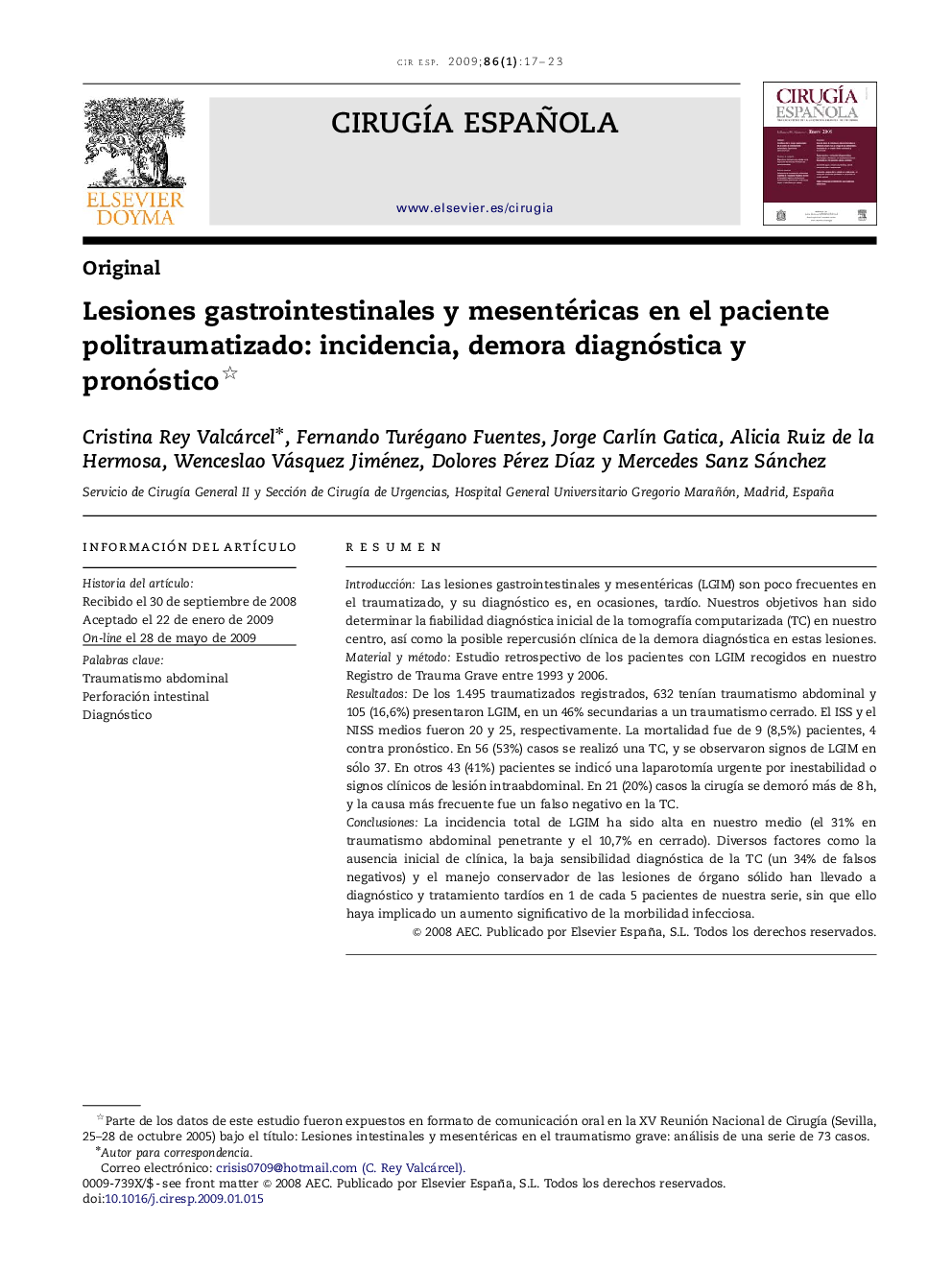| Article ID | Journal | Published Year | Pages | File Type |
|---|---|---|---|---|
| 4253654 | Cirugía Española | 2009 | 7 Pages |
ResumenIntroducciónLas lesiones gastrointestinales y mesentéricas (LGIM) son poco frecuentes en el traumatizado, y su diagnóstico es, en ocasiones, tardío. Nuestros objetivos han sido determinar la fiabilidad diagnóstica inicial de la tomografía computarizada (TC) en nuestro centro, así como la posible repercusión clínica de la demora diagnóstica en estas lesiones.Material y métodoEstudio retrospectivo de los pacientes con LGIM recogidos en nuestro Registro de Trauma Grave entre 1993 y 2006.ResultadosDe los 1.495 traumatizados registrados, 632 tenían traumatismo abdominal y 105 (16,6%) presentaron LGIM, en un 46% secundarias a un traumatismo cerrado. El ISS y el NISS medios fueron 20 y 25, respectivamente. La mortalidad fue de 9 (8,5%) pacientes, 4 contra pronóstico. En 56 (53%) casos se realizó una TC, y se observaron signos de LGIM en sólo 37. En otros 43 (41%) pacientes se indicó una laparotomía urgente por inestabilidad o signos clínicos de lesión intraabdominal. En 21 (20%) casos la cirugía se demoró más de 8 h, y la causa más frecuente fue un falso negativo en la TC.ConclusionesLa incidencia total de LGIM ha sido alta en nuestro medio (el 31% en traumatismo abdominal penetrante y el 10,7% en cerrado). Diversos factores como la ausencia inicial de clínica, la baja sensibilidad diagnóstica de la TC (un 34% de falsos negativos) y el manejo conservador de las lesiones de órgano sólido han llevado a diagnóstico y tratamiento tardíos en 1 de cada 5 pacientes de nuestra serie, sin que ello haya implicado un aumento significativo de la morbilidad infecciosa.
BackgroundGastrointestinal and mesenteric injuries (GIMI) are uncommon in trauma patients, and their diagnosis are often delayed. Our aims were to determine the reliability of CT scan in our centre, and to assess the clinical significance of a delayed diagnosis.Materials and methodRetrospective analysis of cases confirmed at laparotomy. Patients were identified at the Severe Trauma Registry of Gregorio Marañón University General Hospital, between 1993 and 2006.ResultsWe found 105 (16.6%) GIMI out of 632 patients with abdominal trauma, in a Registry with 1495 severe trauma cases included. A total of 46% had blunt injuries. The mean injury severity score (ISS) and new ISS (NISS) were 20 and 25, respectively. There were 9 (8.5%) deaths, 4 of which were unexpected. A CT scan was performed in 56 (53%) cases, and only in 37 there were signs suggestive of a GIMI. In another 43 (41%) patients an urgent laparotomy was indicated because of positive clinical findings or instability. Surgery was delayed for more than 8 hours in 21 (20%) patients, the most common reason being a false negative result in the CT scan.ConclusionsThe overall incidence of GIMI was high in our centre (31% due to penetration and 10.7% blunt trauma). Several factors, such as the initial lack of symptoms, a low diagnostic sensitivity of the CT scan (34% false negatives), and the non-surgical management of solid organ injuries, have contributed to a delayed diagnosis and treatment in one out of each five patients in our series, but this has not led to a significant increase in septic complications in this group.
